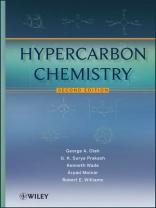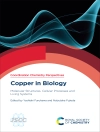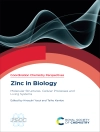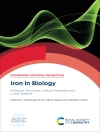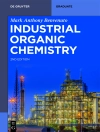The essential new edition of the book that put hypercarbon
chemistry on the map
A comprehensive and contemporary treatment of the chemistry of
hydrocarbons (alkanes, alkenes, alkynes, and aromatics) towards
electrophiles, Hypercarbon Chemistry, Second Edition deals
with all major aspects of such chemistry involved in hydrocarbon
transformations, and of the structural and reaction chemistry of
carboranes, mixed hydrides in which both carbon and boron atoms
participate in the polyhedral molecular frameworks.
Despite the firmly established tetravalency, carbon can bond
simultaneously to five or more other atoms. ‘Hypercarbon’ bonding
permeates much organic, inorganic and organometallic chemistry, and
the book serves as the compendium for this phenomenon.
Copious diagrams illustrate the rich variety of hypercarbon
structures now known, and patterns therein. Individual chapters
deal with specific categories of compound (e.g. organometallics,
carboranes, carbocations) or transformations that proceed through
transient hypercarbon species, detailing fundamental chemistry,
including reactivity, selectivity, stereochemistry, mechanistic
factors and more.
قائمة المحتويات
Foreword to the First Edition xiii
Preface to the Second Edition xv
Preface to the First Edition xvii
1. Introduction: General Aspects 1
1.1. Aims and Objectives 1
1.2. Some Definitions 2
1.3. Structures of Some Typical Hypercarbon Systems 5
1.4. The Three-Center Bond Concept: Types of Three-Center Bonds
10
1.5. The Bonding in More Highly Delocalized Systems 21
1.6. Reactions Involving Hypercarbon Intermediates 26
References 31
2. Carbon-Bridged (Associated) Metal Alkyls 37
2.1. Introduction 37
2.2. Bridged Organoaluminum Compounds 41
2.3. Beryllium and Magnesium Compounds 50
2.4. Organolithium Compounds 53
2.5. Organocopper, Silver, and Gold Compounds 58
2.6. Scandium, Yttrium, and Lanthanide Compounds 62
2.7. Titanium, Zirconium, and Hafnium Compounds 64
2.8. Manganese Compounds 66
2.9. Other Metal Compounds with Bridging Alkyl Groups 68
2.10. Agostic Systems Containing
Carbon-Hydrogen-Metal 3c-2e Bonds
70
2.11. Conclusions 76
References 77
3. Carboranes and Metallacarboranes 85
3.1. Introduction 85
3.2. Carborane Structures and Skeletal Electron Numbers 87
3.4. MO Treatments of Closo Boranes and Carboranes
104
3.5. The Bonding in Nido and Arachno Carboranes
107
3.6. Methods of Synthesis and Interconversion Reactions 111
3.7. Some Carbon-Derivatized Carboranes 114
3.8. Boron-Derivatized Carboranes: Weakly Basic Anions
[CB11H6X6]- 122
3.9. Metallacarboranes 123
3.10. Supraicosahedral Carborane Systems 133
3.11. Conclusions 137
References 137
4. Mixed Metal-Carbon Clusters and Metal Carbides
149
4.1. Introduction 149
4.2. Complexes of Cn Hn Ring Systems with a Metal
Atom: Nido-Shaped MCn Clusters 150
4.3. Metal Complexes of Acyclic Unsaturated Ligands,
Cn Hn+2 157
4.4. Complexes of Unsaturated Organic Ligands with Two or More
Metal Atoms: Mixed Metal-Carbon Clusters 160
4.5. Metal Clusters Incorporating Core Hypercarbon Atoms 162
4.6. Bulk Metal Carbides 173
4.7. Metallated Carbocations 176
4.8. Conclusions 176
References 177
5. Hypercoordinate Carbocations and Their Borane Analogs
185
5.1. General Concept of Carbocations: Carbenium Versus Carbonium
Ions 185
5.2. Methods of Generating Hypercoordinate Carbocations 188
5.3. Methods Used to Study Hypercoordinate Carbocations 189
5.4. Methonium Ion (CH5 ¯+) and Its Analogs
195
5.5. Homoaromatic Cations 247
5.6. Hypercoordinate (Nonclassical) Pyramidal Carbocations
260
5.7. Hypercoordinate Heterocations 266
5.8. Carbocation-Borane Analogs 268
5.9. Conclusions 276
References 277
6. Reactions Involving Hypercarbon Intermediates 295
6.1. Introduction 295
6.2. Reactions of Electrophiles with C-H and C-C
Single Bonds 298
6.3. Electrophilic Reactions of pi-Donor Systems 383
6.4. Bridging Hypercoordinate Species with Donor Atom
Participation 388
6.5. Conclusions 394
References 394
Conclusions and Outlook 417
Index 419
عن المؤلف
GEORGE A. OLAH, Ph D, is the 1994 Nobel Laureate in
Chemistry, Founding Director of the Loker Hydrocarbon Research
Institute, and Distinguished Loker Chair Professor at the
University of Southern California. A pioneer in the hypercarbon
chemistry field, Dr. Olah has published numerous papers, books, and
monographs.
G. K. SURYA PRAKASH, Ph D, is the George A. and Judith A.
Olah Nobel Laureate Chair Professor and the Director of the Loker
Hydrocarbon Research Institute at the University of Southern
California.
KENNETH WADE, Ph D, DSc, FRS, is an Emeritus Professor at
the University of Durham, UK and a Senior Fellow of the Loker
Hydrocarbon Research Institute at the University of Southern
California.
ÁRPÁD MOLNÁR, DSc, is an Emeritus
Professor at the University of Szeged, Hungary, and a Senior Fellow
of the Loker Hydrocarbon Research Institute at the University of
Southern California.
ROBERT E. WILLIAMS, Ph D, is a Senior Fellow of the Loker
Hydrocarbon Research Institute at the University of Southern
California.
